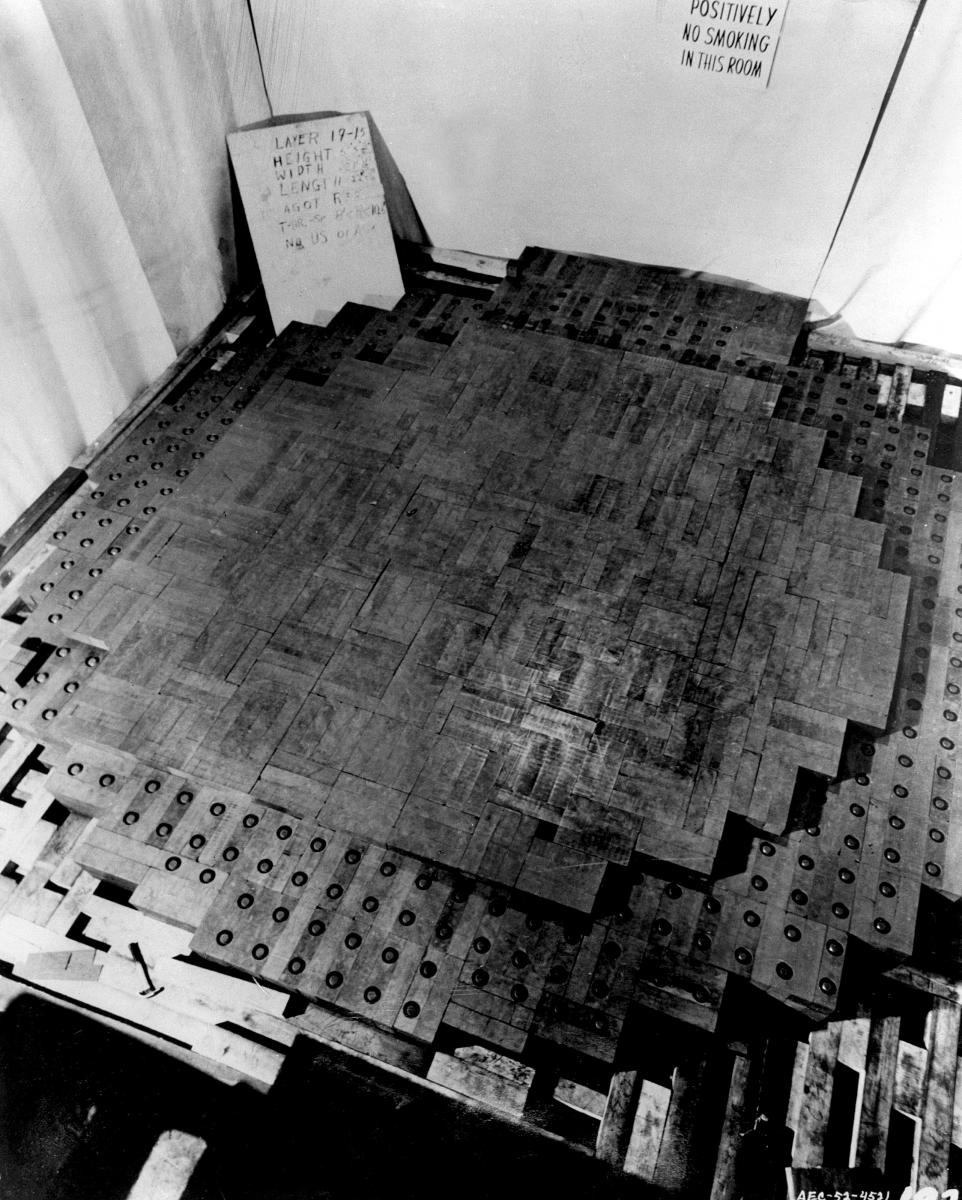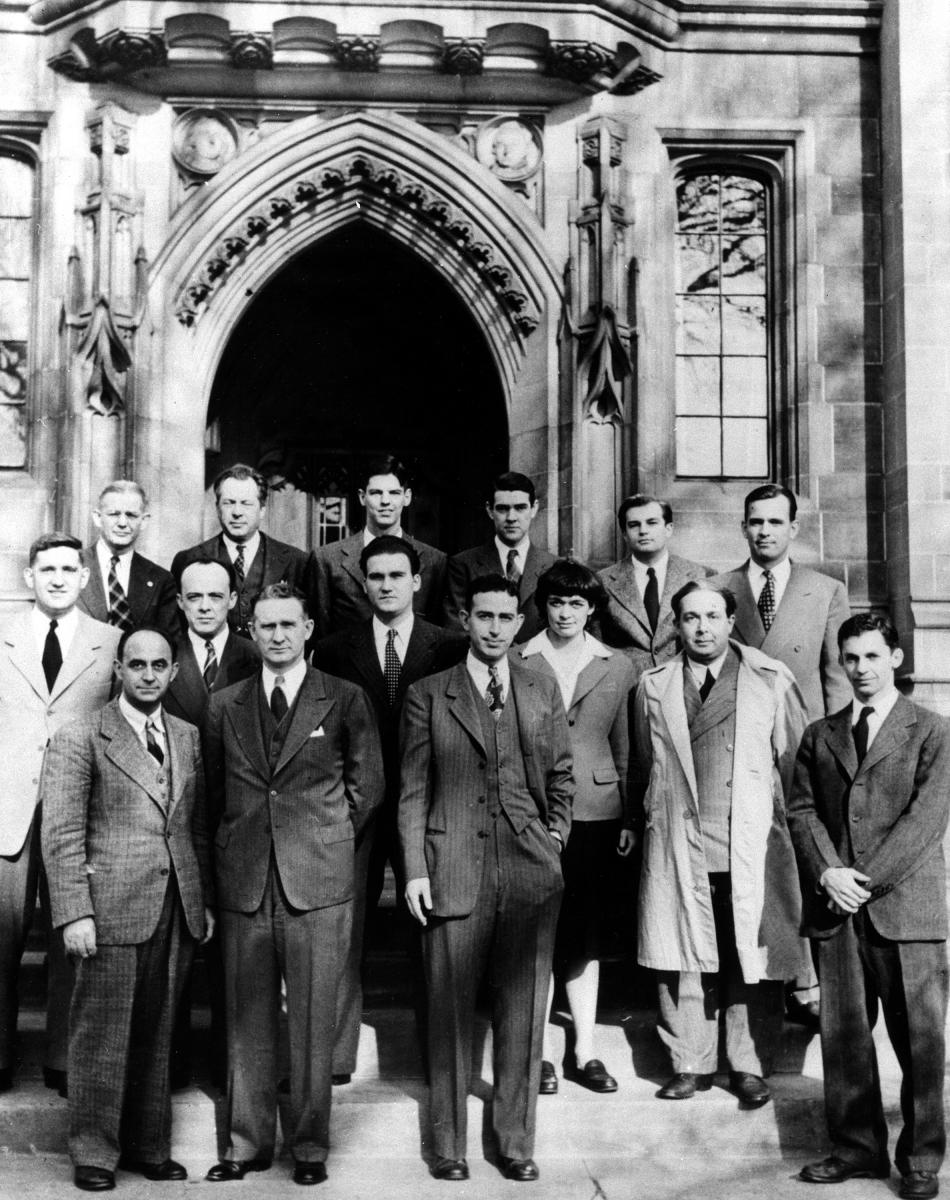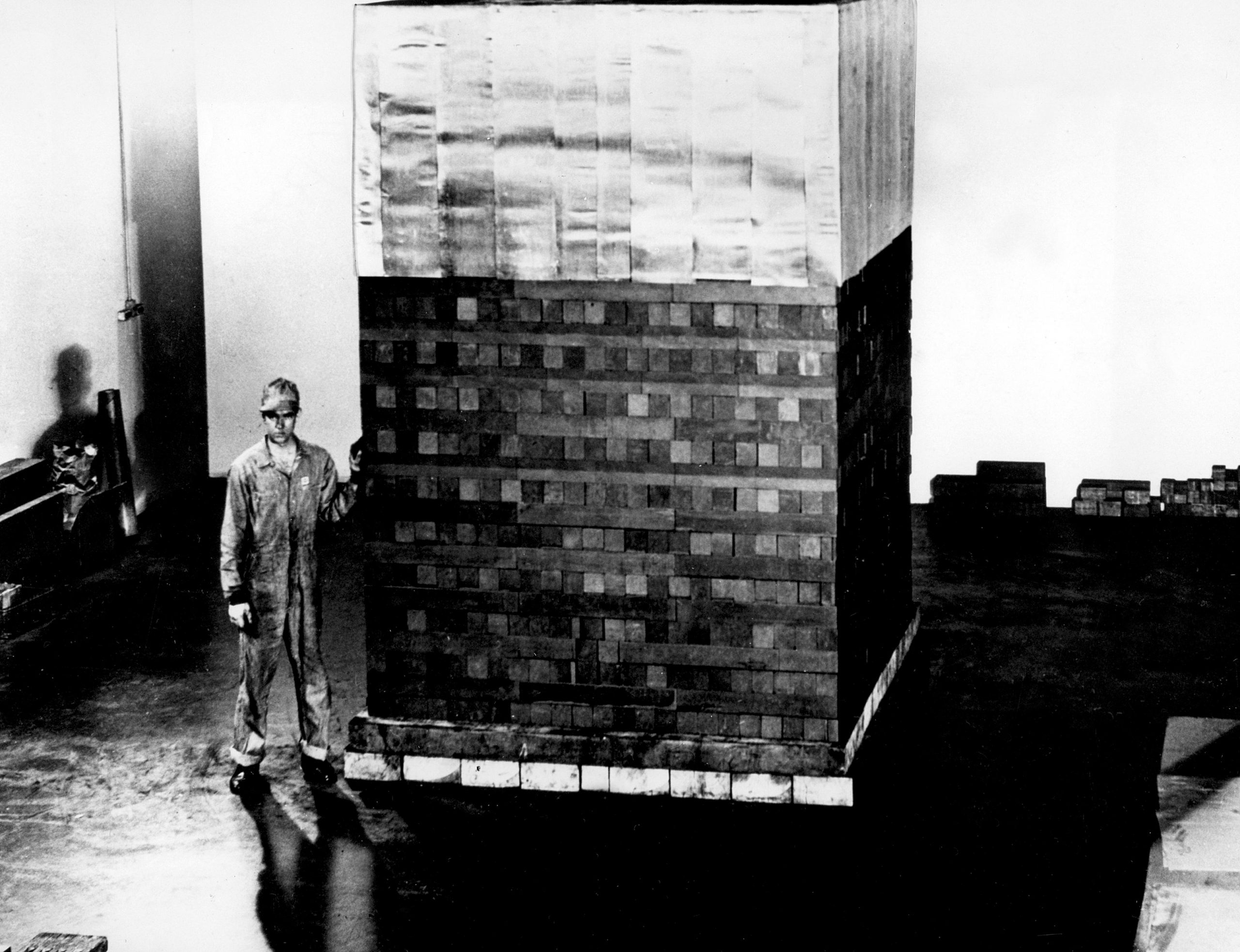One of the most important branches of the far-flung Manhattan Project was the Metallurgical Laboratory at the University of Chicago. Known simply as the “Met Lab”, its primary role was to design an atomic reactor, created through chain-reacting piles. The Met Lab’s most notable accomplishment was Chicago Pile-1 – the world’s first artificial nuclear reactor. A group began designing the production pile in June 1942, building it under the west stands of Stagg Field. In the meantime, Enrico Fermi studied the fundamentals of pile operation, building a small experimental unit – the Chicago Pile-1 – to be completed and in operation by the end of the year. His goal was to reach a reproduction value (k) of one, which would cause the reaction to continue indefinitely.
On the afternoon of December 2, 1942, Chicago Pile-1 went critical. It demonstrated a k value of 1.0006, and was allowed to reach a thermal output of 0.5 watts (ultimately it operated at 200 watts maximum). The continuous chain reaction was witnessed by Leo Szilard, Eugene Wigner, and DuPont engineer Crawford Greenewalt along with dozens of others. Click here for the full list of those present. Fermi’s basic design would be expanded and built at Hanford as the B Reactor.
Here are some excerpts from interviews with Manhattan Project veterans, in which they recall the construction and success of the Chicago Pile-1. For the full interviews, visit our oral history website, “Voices of the Manhattan Project.”
Harry Kamack: The two of us found our way to the University of Chicago and to what was called the Metallurgical Laboratory, which everybody called the Met Lab.
 We showed our credentials and we got taken to an office where there was a DuPont representative named Dr. Walter Dew.
We showed our credentials and we got taken to an office where there was a DuPont representative named Dr. Walter Dew.
And he sat the two of us down and he said, “Have you made any guesses as to what this is all about?”
And of course, we’d been doing a lot of guessing, but we said, “No.”
He said, “I’ll tell you in a few words. It’s about atomic energy. We’re going to use atomic energy to make a bomb.” Then he opened a drawer and he pulled out a couple little cubes of metal and threw them on the table and said, “You know what this is?”
So I picked one of them up. It was this little cube about so big and it felt very heavy so I said, “I don’t know. It’s very dense.”
He said, “Well, that’s uranium. We’re going to make a pile with uranium and graphite, and in this pile we’re going to make a new element called plutonium. And with this plutonium we’re going to make a bomb.” I nor I’m sure the other fellow had the slightest idea what he was talking about, and the whole thing seemed just very incredible.
Samuel K. Allison: The first effort was to get the chain reaction going as soon as possible. In May 1942, we had an assemblage of materials—that is, graphite and metallic uranium and some powdered uranium oxide. This assemblage was not sufficient to start the chain reaction, but put together it multiplied neutrons sufficiently so that we were sure that if we had enough material of the same kind, the chain reaction would begin. In other words, the question was simply one of enlarging the small structure we had built with the stuff we could get.
So the period from May 1942 to December 1942 was mainly one of waiting for industry to make tons of material, which we had only available in pounds in May. But industry responded, the stuff began to come in, and on December 2nd, 1942 the last shipment came in. It was immediately stacked onto the structure and Professor Fermi demonstrated that the chain reaction would initiate, would begin, would carry on, and could be controlled. And the last, of course, was just as important as the other. It’s one thing to begin the reaction, it’s another, equally important to show that you can stop it and control it. But this was very successfully demonstrated. There was never any question of the thing getting out of control.
 Darragh Nagle: Chicago was the scene of intense activity. The West Stands was where the pile was. That was an interesting place—it was the old west stands of the football stadium. It was built in gothic style; it had lots of ivy on the outside and it was very black, because there was a lot of smoke in Chicago then. All in all it was a very gloomy place from the outside. It looked like a good setting for a third-rate murder mystery or something. And inside it was even better because there were lots of people in overalls, absolutely black, and just red eyes shining out of these black faces. The black was graphite, of course.
Darragh Nagle: Chicago was the scene of intense activity. The West Stands was where the pile was. That was an interesting place—it was the old west stands of the football stadium. It was built in gothic style; it had lots of ivy on the outside and it was very black, because there was a lot of smoke in Chicago then. All in all it was a very gloomy place from the outside. It looked like a good setting for a third-rate murder mystery or something. And inside it was even better because there were lots of people in overalls, absolutely black, and just red eyes shining out of these black faces. The black was graphite, of course.
Herbert Anderson: I was in charge of the night shift. We had a discussion with [Enrico] Fermi during the day about what we should do. We had already estimated, from the data of previous nights, at the 51st layer, the pile would be in a critical condition. We could usually put on some four or five layers a night. We had agreed that when I reached the 51st layer, we would go home.
I realized that I could have had the honor of being the first one. I had an agreement with Professor Fermi. He knew that I would be tempted. I was really quite loyal to him. I would not do it. I might think of it, but I would not do it.

He was very much the showman on that day. He wanted to impress everyone with the achievement, really. It was essentially to demonstrate how thoroughly he understood everything. It was very much showmanship. He had a lot of people watching. He was really showing his mastery of the whole thing. He just enjoyed it tremendously. He had a little six-inch slide rule. He used it to calculate. He would record the data and then calculate where the next should be. He prepared himself quite well, you see, to know what to do with each new measurement. He had a chart already prepared, so that he knew pretty well. He was very calm about everything. I do not think any of us were nervous, those of us who had worked with this a long time. In a sense, it was what we had been thinking about for several years.
Evelyne Litz: He [husband Lawrence Litz] started working for Fermi under the grandstand. He couldn’t tell me anything about it except he was very excited and very happy about it. And then one day he came home, and something happened that was quite interesting. All the physicists were betting on a certain time that something would go radioactive. They all put money in a pile, and Larry won the money.
Crawford Greenewalt: The whole atmosphere in that place was one of relative calm. There was always the remote chance that the reaction would get out of control. The physicists and Fermi had thought the chance was exceedingly remote, but on the other hand no matter how remote they wanted to take all the precautions they could.
The last resort precaution was that they had a platform at the corner of the pile, level with the top of it. Cadmium is a very strong neutron absorber. These fellows, there were two or three that were on this platform at the end and they had on the platform buckets of strong cadmium nitrate solution. The idea was that if the reaction could not be controlled by the control rods and seemed to be getting away they were to run out on top of the structure and pour the buckets of cadmium nitrate. Physically, by hand pour it in. This was supposed to stop the reaction, but this was simply the remote precaution. Well, it was not necessary at all and I do not think I had any feeling of fear.
Enrico Fermi: The event…would not have seemed in any way spectacular to a casual observer. You would have seen a large black graphite structure, of which there is a scale model, supported in part by a scaffolding of wooden beams. You would have seen a number of people reading instruments and recording their results. Perhaps you might not even have noticed many signs of excitement in their faces.
Arthur Holly Compton: We entered the balcony at one end of the room. On the balcony, a dozen scientists were watching the instruments and handling the controls. Across the room was a large cubical pile of graphite and uranium blocks, in which we hoped the atomic chain reaction would develop. Inserted into openings in this pile of blocks were control and safety rods. After a few preliminary tests, Fermi gave the order to withdraw the control rod another foot. We knew that that was going to be the real test. The Geiger counters registering the neutrons from the reactor began to click faster and faster, until their sound became a rattle. The reaction grew until there might be danger from the radiation up on the platform where we were standing. “Throw in the safety rods,” came Fermi’s order. And you could see the pointer move right back to zero. The rattle of the counters fell to a slow series of clicks. For the first time, atomic power had been released. It had been controlled and stopped.
Leona Marshall Libby: Then somewhat later, after the control rods were all put to bed and the charts were pulled out and clipped up and so on, Eugene Wigner showed up with a famous little flask of Chianti. He poured it into a paper cup. He went and drank it very quietly. There was no toast, nothing, no remarks. Nothing very dramatic, really: The most effective kind of drama probably at that point.
Greenewalt: I remember very well Wigner reaching under a desk and pulling out a bottle of Chianti in a brown paper bag, and handing it to Fermi with a bow. Well, here again, no great excitement, no cheers, just satisfaction that the experiment had worked. I think that was really the atmosphere, or the feeling that I had in my mind—“Thank God that one’s over.”





